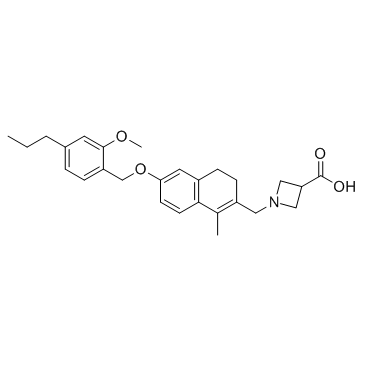| Description |
Ceralifimod is selective, high potent agonist for sphingosine 1-phosphate receptors 1 and 5, with EC50s of 27.3, 334 pM for human S1P receptor 1 and 5, respectively.
|
| Related Catalog |
|
| Target |
EC50: 27.3 pM (hS1P1), 334 pM (hS1P5)[1].
|
| In Vitro |
Ceralifimod (ONO-4641) inhibits the specific binding of [33P]-S1P to hS1P1 and hS1P5 in a concentration dependent manner, with Ki values of 0.626 and 0.574 nM, respectively. Ceralifimod also inhibits the specific binding to hS1P4, but the Ki value of Ceralifimod is 28.8 nM, approximately 50 times higher than those for hS1P1 and hS1P5. The Ki value of Ceralifimod for rS1P1 is 0.772 nM. The EC50 values of Ceralifimod for hS1P1 and hS1P5 are 0.0273 and 0.334 nM, respectively. Ceralifimod also has an agonistic action on rS1P1 with an EC50 value of 0.0286 nM[1].
|
| In Vivo |
The clinical scores of the Ceralifimod 0.03 and 0.1 mg/kg groups remain lower than that in the control group. The maximum clinical scores decrease dose-dependently in the Ceralifimod groups and those in the Ceralifimod 0.03 and 0.1 mg/kg groups are significantly lower than that in the control group. Specifically, paralysis is inhibited completely in seven of eight animals in the Ceralifimod 0.1 mg/kg group. In normal NOD mice, the number of peripheral blood lymphocytes is decreased by approximately 20, 60 and 80% at 24 h after a single oral dose of 0.01, 0.03 and 0.1 mg/kg of Ceralifimod, respectively. In the control group of the NOD mouse model of relapsing-remitting EAE, the relapse rate is 90.0%, and two of the nine animals die. The cumulative clinical score in the control group is 65.4±18.50. In contrast, none of animals in the Ceralifimod 0.1 mg/kg group have a relapse; that is, Ceralifimod completely prevents relapse at a dose of 0.1 mg/kg. In the Ceralifimod groups, two of the nine animals in the 0•01 mg/kg die[1].
|
| Animal Admin |
Rats, Mouse[1] Female Lewis rats are immunized by subcutaneous administration of the inducer at a volume of 0.1 mL into the footpad. Ceralifimod (ONO-4641: 0.01, 0.03 and 0.1 mg/kg), prednisolone (3 mg/kg) or 0.5% MC is administered orally once daily from immunization days 4-21. More specifically, the severity of paralysis is graded on a scoring scale to determine the clinical score. NOD mice are immunized into the left footpad with the inducer at a volume of 0.05 mL. A second PTX injection is administered 48 h later. Animals that achieve remission after the initial onset are selected and grouped, and Ceralifimod (0.01, 0.03 or 0.1 mg/kg) or 0.5% MC is administered orally to each group once daily for 8 weeks. Neurological symptoms are graded according to the degree of paralysis. A clinical score of 5 is assigned to dead animals until the end of observation[1].
|
| References |
[1]. Komiya T, et al. Efficacy and immunomodulatory actions of ONO-4641, a novel selective agonist for sphingosine 1-phosphate receptors 1 and 5, in preclinical models of multiple sclerosis. Clin Exp Immunol. 2013 Jan;171(1):54-62.
|
